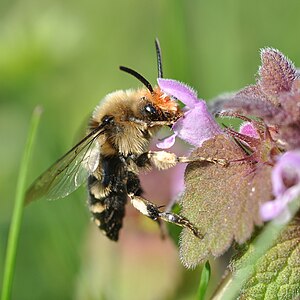Common mourning bee
| Common mourning bee | ||||||||||||
|---|---|---|---|---|---|---|---|---|---|---|---|---|

Common mourning bee ( Melecta albifrons ) with orange hairstyle due to pollen from dead nettle |
||||||||||||
| Systematics | ||||||||||||
|
||||||||||||
| Scientific name | ||||||||||||
| Melecta albifrons | ||||||||||||
| ( Forster , 1771) |
The common mourning bee ( Melecta albifrons ) is a brood parasitic bee from the genus of the mourning bees ( Melecta ).
features
The bees reach a body length of 12 to 17 millimeters. They can be easily distinguished from the other species of weeping bees in Central Europe by their brownish-yellow hair on the head, the equally thick thoracic hair and the two beige spots on the outside of each tergite . Your abdomen is somewhat pointed. Due to their way of life, they do not have a pollen collecting device. It is difficult to distinguish between males and females; the females have one less antennae than the males with 12 antennae.
Occurrence
The species occurs in large parts of Europe and in all of Central Europe from the lowlands to around 500 meters above sea level. Like its host species, it settles on steep banks on rivers, sand, gravel and clay pits, vineyards with dry stone walls or loess walls, but also unplastered clay walls on buildings. Like its host species, it is widespread in Central Europe and in some places it occurs frequently. It is not endangered because of the frequency of its main host.
Way of life
The larvae of the common mourning bee develop parasitically as cuckoo bees on the common fur bee ( Anthophora plumipes ), but also on other fur bees such as Anthophora plagiata and Anthophora fulvitarsis .
The adults suck nectar from many different plants, such as coltsfoot , gundermann , purple dead nettle and white dead nettle, or creeping günsel . A generation is formed each year that flies from the beginning of April to the end of May (males) or the end of June (females). The animals are usually found in large numbers near the nesting sites of their hosts. The females of the common mourning bee lay their eggs shortly before the brood cell is closed, whereby the cell lid is pierced with the pointed end of the abdomen. The egg lies on the underside of the cell cover. Occasionally there will be arguments between the host and the parasitoids when the former returns to the nest. As with other cuckoo bees, the grief bee larva presumably first eats the host egg or the larva that has already hatched after hatching and then feeds on the stored food supply. Hibernation takes place as an imago in the brood cell.
swell
literature
- Heiko Bellmann : bees, wasps, ants. Hymenoptera of Central Europe . Franckh-Kosmos Verlags-GmbH & Co KG, Stuttgart 1995, ISBN 3-440-09690-4 .
- Andreas Müller, Albert Krebs, Felix Amiet: Bees. Central European species, way of life, observation. Naturbuch-Verlag, Augsburg 1997, ISBN 3-89440-241-5 .